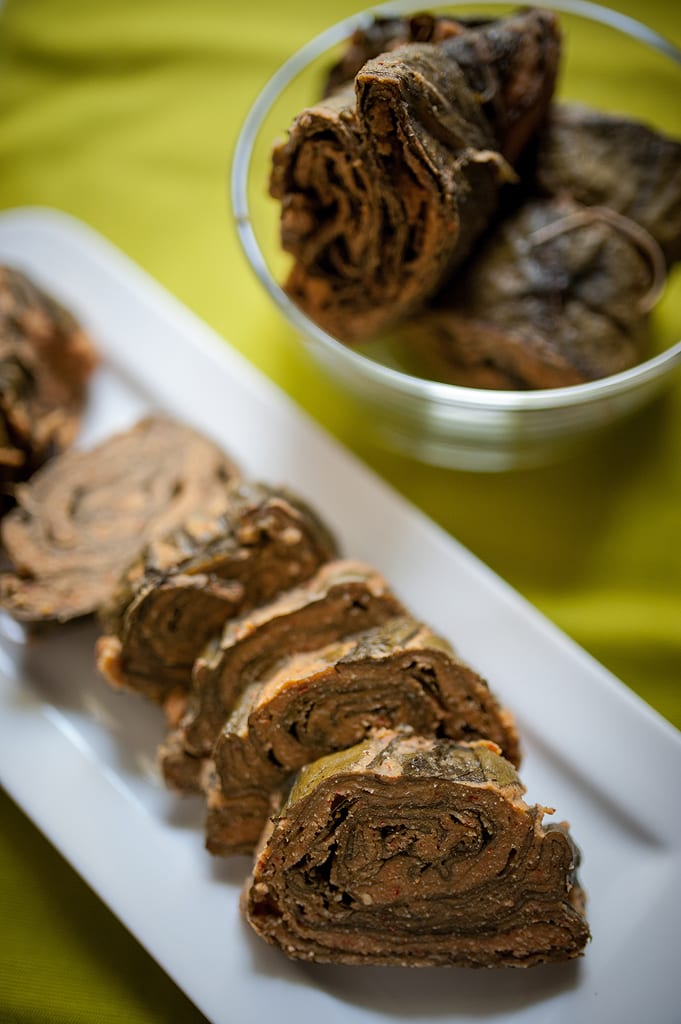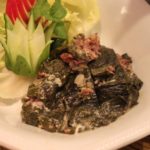

UP YOUR DINNER PLANS WITH THIS DELICIOUS AND HEALTHY DALO LEAVES...
It's the start of the new year, and we know you're thinking it's time to eat healthy. Well, there's no better way to up your health game than integrating dalo leaves into your diet. These delicious tropical leaves are packed with nutrients and flavor that can really change the way you eat vegetables. We did the homework for you and putt together the Ultimate Guide to dalo leaves (taro leaves).
TARO LEAVES BENEFITS

Mama was most certainly right to tell you to eat your leafy green vegetables. Taro leaves are the ultimate leafy green that has so many health benefits.
Not only are they packed with nutrients, they also grow verdantly year round in river banks and marshy tropical lands. Some other names for taro are luau, kalo, malenga, elephant's ear, keladi, alu, taloes, dalo, and dasheen. Also, there are about 87 varieties and subspecies of taro known today.
However, be cautious when you first start cooking with dalo leaves. Eating taro can be very good for you but you MUST remember to cook it all the way through. Raw taro can be dangerous since the calcium oxalate in the taro is a numbing agent.
It is pertinent that you cook the taro for at least 10 minutes before consuming.
Antioxidants
Taro leaves are rich in Vitamin C, which is an antioxidant that helps prevent cancer. It also helps fight free radicals and other harmful diseases
Immune System
In just one cup of taro leaves, you get 86% of your daily value in Vitamin C. This is extremely helpful for boosting your immune system and fighting off disease.
Eye Health
Not only are taro leaves rich in Vitamin C, they also yield a 123% daily value of Vitamin A. This essential vitamin is helpful for preventing glaucoma, cataracts, myopia, and other eye diseases.
Weight Loss
One of the major benefits of taro leaves is they are packed with protein and fiber. These are excellent for gaining muscle and also making you feel more full.
Digestion
Because taro leaves are high in dietary fiber, they help keep your digestion moving and absorbs other food. It helps prevent from indigestion, constipation, and diarrhea.
HOW TO CLEAN TARO LEAVES FOR COOKING
Taro is a verdant plant that grows in many tropical climates. Since most tropical weather is high in moisture, taro leaves thrive in places like Fiji and other islands.
These plants are edible from root to leaf making it a desirable crop for harvesters. Since the roots and leaves are very close to the ground, they are more susceptible to soil-borne diseases such as E. coli. So, it's extremely important to clean the leaves properly before consuming them.

Here's a breakdown on how to clean taro leaves for cooking:
- Before handling any vegetables, always wash your hands properly for 20 seconds or more using soap and water.
- Next, cut the ends of the stems where the stems of the leaves are damaged or old. Also, cut away any old pieces of the leaf as well.
- Then, hold one leaf at a time under cold running water while wiping the leaf with your hand. Flip the leaf over and repeat until the dirt is washed away.
- Finally, dry the leaf one at a time with a paper towel. Set the leaf down to dry on a paper town and continue to place paper towels in between each leaf as you wash them. Press gently on the stack of dried leaves when done to squeeze excess water.
HOW TO COOK TARO LEAVES
Steaming Taro Leaves

One way to cook taro leaves is to steam them. Steaming allows the fibrous texture in the leaves to break down without losing the vital nutrients in the leaves.
The dish shown above is Pathrado which is a Konkani and Malvani dish from the konkan region. The leaves are rolled with a delicious coarse paste made from rice, lentils and spices. This is an excellent way to get a boost of flavor while eating your vegetables at the same time.
Many people tend to steam the leaves since it's the easiest way to cook them. However, always remember to steam them four around 3 hours to break down the harmful chemicals in the leaves.
Taro Leaves in the Pressure/Slow Cooker
If you're looking for a quick or easy way to get your taro leaves cooked down and delicious, you've come to the right place. Cooking taro leaves in the pressure cooker allows them to cook down quickly without loosing flavor or texture.
The slow cooker is an excellent option as well. You can throw the leaves in the crockpot overnight and wake up to a delicious Fijian side dish ready to go. This is an excellent way for those that are busy and can't be around the kitchen to watch the leaves cook.
How to Cook Taro Leaves in Coconut Milk (Palusami)
One of the most traditional Polynesian dishes with taro leaves is palusami. This tasty and healthy treat is actually cooked with dalo leaves and the vehicle of cooking.
First, you add the filling and coconut into two layers of taro leaves. Then the leaves are tied off and placed inside tin foil. The foiled bundles are then set over heat or in an oven for several hours allowing the coconut milk to seep through into the leaves and break down the fibrous texture.
You also have the option of added ground meat to give it a little extra kick.
Palusami is a common dish in the traditional Fijian lovo feasts.
Stewed Taro Leaves
Stewing dalo leaves is the most universally known way to cook delicious taro. Since the leaves require careful cooking and breaking down of the calcium oxalate, stewing is the best way to ensure that the leaves are fully cooked.
Also, stewing allows the spices and flavors to seep into the leaves. You get the best flavor and texture when stewing the leaves. The leaves themselves are pretty tough and fibrous, so it is difficult to over cook the leaves.
Below is a great example of a Mauritian Stewed Taro Leave recipe. Also, if you scroll down to the bottom of this article, you'll find the best rourou recipe. Rourou is the Fijian version of stewed dalo leaves.
WHERE TO BUY TARO LEAVES
If you're living in an area where there are more Caribbean or Asian stores, you're more likely to walk in and make a purchase. However, this isn't always the case.
Sometimes, if you check out your local farmer's market, you might get lucky and find someone selling the perfect dalo leaves.
You also have the option fo growing them yourself. Since taro is an extremely successful species, many people have found it to be relatively easy to grow, even in colder weather.
For those of you who want to get them fast and get them now, there are also dehydrated and dried options below.
THE BEST FIJIAN ROUROU RECIPE

The Best Fijian Rourou Recipe
Rourou is delicious dalo leaves cooked and prepared in a traditional Fijian way. These leaves make a delicious and healthy side dish.
Ingredients
- 4 taro leaves
- 1 cup water
- 1 cup coconut cream
- 1 chopped onion
- 1 tsp chopped garlic
- salt to taste
- 1 canned meat
Instructions
-
Prepare the taro leaves by cleaning them and removing the fibrous stems so that there are only leaves. Wash and slice very thinly.
-
Boil 1 cup of water and 1 cup of coconut cream. Add salt, garlic, onion, and canned meat. Then, add the taro leaves. Bring to boil for about 15-20 minutes with the lid off. Stir occasionally.
-
It is very important to boil the taro leaves thoroughly since they can be highly acidic and bad for your stomach/throat. Remember to boil the leaves AT LEAST 10 minutes.
-
Serve the mixture as a delicious and healthy side dish.
NomList.com is a participant in the Amazon Services LLC Associates Program, an affiliate advertising program designed to provide a means for sites to earn advertising fees by advertising and linking to Amazon.com. CERTAIN CONTENT THAT APPEARS ON THIS SITE COMES FROM AMAZON SERVICES LLC. THIS CONTENT IS PROVIDED 'AS IS' AND IS SUBJECT TO CHANGE OR REMOVAL AT ANY TIME. Product prices and availability are accurate as of the date/time indicated and are subject to change. Any price and availability information displayed on Amazon.com at the time of purchase will apply to the purchase of this product. All prices on this site may change and those considered valid are displayed on Amazon.com







